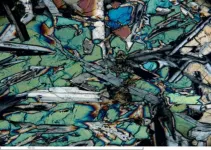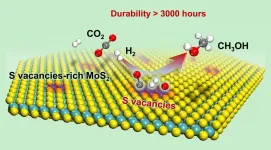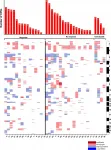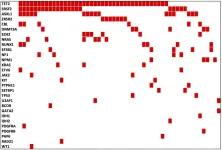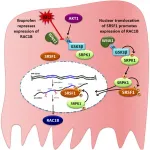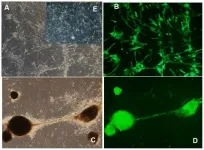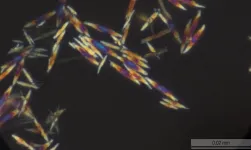INFORMATION:
The research team's findings have been published in Nature Communications. The team included scientists from Australia, Japan, USA, Germany, UK, China, and Switzerland.
Further information
Basalt derived from highly refractory mantle sources during early Izu-Bonin-Mariana arc development is published by Nature Communications. DOI: 10.1038/s41467-021-21980-0
The research was part of the International Ocean Discovery Program (IODP).
Dr Savov was funded by the Natural Environment Research Council.
The research team also included: Center of Deep Sea Research, Institute of Oceanology, Chinese Academy of Sciences, Qingdao, China; Laboratory for Marine Mineral Resources, Qingdao National Laboratory for Marine Science and Technology, Qingdao, China; Center for Ocean Mega-Science, Chinese Academy of Sciences, Qingdao, China; Research School of Earth Sciences, Australian National University, Canberra, Australia; Geological Survey of Japan/AIST, Tsukuba, Ibaraki, Japan; Department of Earth & Environment, AHC5-394, Florida International University, Miami, USA; Department of Earth & Ocean Sciences, University of South Carolina, Columbia, USA; Institute of Earth Sciences, University of Lausanne, Switzerland; School of Earth Sciences, University of Bristol, UK; GEOMAR Helmholtz Centre for Ocean Research Kiel, Germany; College of Earth, Ocean, and Atmospheric Sciences, Oregon State University, USA.
Picture credit: Exp. 351 Science Team
For further details, contact Ian Rosser in the University of Leeds press office on i.rosser@leeds.ac.uk
New basalt type discovered beneath the ocean
2021-03-22
(Press-News.org) A new type of rock created during large and exceptionally hot volcanic eruptions has been discovered beneath the Pacific Ocean.
An international team of researchers including the University of Leeds unearthed the previously unknown form of basalt after drilling through the Pacific ocean floor.
The discovery suggests that ocean floor eruptions sourced in the Earth's mantle were even hotter and more voluminous than previously thought. Report co-author is Dr Ivan Savov, of Leeds' Institute of Geophysics and Tectonics, in the university's School of Earth and Environment.
He said: "In an era when we rightly admire discoveries made through space exploration, our findings show there are still many discoveries still to make on our own planet.
"The rocks that we recovered are distinctly different to rocks of this type that we already know about. In fact, they may be as different to Earth's known ocean floor basalts as Earth's basalts are to the Moon's basalts.
"Now that we know where and how this rock type is formed, we anticipate that many other rocks that we know were originally formed by ocean floor eruptions will be re-examined and potentially alter our wider understanding of the basalt formation."
The newly-discovered basalt is distinct from known rocks in both its chemical and mineral makeup.
Its existence was previously not known because no new examples have been formed in millions of years. As a result, the new basalt type lay buried deep beneath sediment at the bottom of the ocean.
To find the new rock, the research team, aboard the Research Vessel (RV) JOIDES "Resolution", sank their drilling equipment 6km down to the ocean floor of the Amami Sankaku Basin - about 1,000km southwest of Japan's Mount Fuji volcano.
They then drilled a further 1.5km into the ocean floor, extracting samples that had never before been examined by scientists.
The research area was part of the birth of the "Ring of Fire" - a horseshoe-shaped belt known for regular volcanic eruptions and earthquakes. It stretches about 40,000 km around the Pacific, and is thought to have begun forming at least 50 million years ago.
Dr Savov explained: "This was one of the deepest waters ever to be considered for drilling, using a research vessel specifically designed for such challenging deep sea environments.
"Basalt is among the most common type of rock on earth. We were looking for basalt that was formed during early Ring of Fire volcanic eruptions.".
The eruptions that created the newly-discovered basalt were very widespread (covering areas the size of western Europe) and occurred in a relatively short geological timescale of between 1-2 million years.
ELSE PRESS RELEASES FROM THIS DATE:
The dirt on crop insurance
2021-03-22
The increasing frequency and severity of extreme weather events like droughts and floods have taken a toll on the midwestern U.S. in recent years, putting a major strain on the region's farmers. From 2001 to 2010, the Federal Crop Insurance Program, a government program created to protect farmers from crop loss, covered $4.1 billion in damages; in 2011 alone, the program paid out $10.8 billion.
With the largest U.S. crop -- corn -- conservatively estimated to drop in yield anywhere from 20 to 80 percent due to extreme weather exacerbated by climate change, insurance claims may skyrocket to levels that may not be sustainable. But researchers from the Yale School of the Environment (YSE) found that by considering soil properties when determining insurance premiums ...
Yale researchers create map of undiscovered life
2021-03-22
Less than a decade after unveiling the "Map of Life," a global database that marks the distribution of known species across the planet, Yale researchers have launched an even more ambitious and perhaps important project -- creating a map of where life has yet to be discovered.
For Walter Jetz, a professor of ecology and evolutionary biology at Yale who spearheaded the Map of Life project, the new effort is a moral imperative that can help support biodiversity discovery and preservation around the world.
"At the current pace of global environmental change, there is no doubt that many species will go extinct before we have ever learned ...
Catalytic hydrogenation of CO2 to methanol: Low temperature, high efficiency, and long working time
2021-03-22
Efficient conversion of CO2 is strategically significant for alleviating the energy crisis and achieving the goal of carbon neutrality. One promising conversion route is the hydrogenation of CO2 to methanol using a renewable energy-based "green hydrogen" source.
Traditional metal oxide catalysts for this reaction typically require a high temperature (>300 oC), which tends to promote undesired reverse water-gas shift (RWGS) side reactions, thus producing a large amount of CO as the by-product.
Introduction of transition metal components onto metal oxides can promote the activation of H2, thereby reducing the reaction temperature, but this also facilitates excessive hydrogenation of CO2 to CH4, leading to lowered methanol selectivity. Further improvement of the performance ...
Study underscores need for multidisciplinary care for COVID-19 long-haulers
2021-03-22
Physicians across the country have analyzed the emerging scientific data about the long-term effects of COVID-19, creating an initial knowledge base about the clinical experiences of so-called "long-haulers" - patients with COVID-19 who experience prolonged symptoms and/or the emergence of new ones well after the initial viral infection has resolved. A comprehensive review published today in Nature Medicine offers an initial glimpse of the multi-organ effects of long-term COVID-19 and suggests a framework for the care of COVID-19 long-haulers through dedicated, multidisciplinary clinics.
"It was important to respond to our patients' concerns and pay close attention to the symptoms they were experiencing beyond the acute phase of COVID-19," said Kartik Sehgal, MD, a lead ...
Oncotarget: Predictors of immunotherapy benefit in Merkel cell carcinoma
2021-03-22
Oncotarget published "Predictors of immunotherapy benefit in Merkel cell carcinoma" which reported that the authors retrospectively analyzed electronic health records and next-generation sequencing data of 45 patients treated at our institution from 2013 to 2020 to understand clinical and genomic correlates of benefit from immunotherapy.
They reported that their cohort predominantly included individuals with stage III disease at primary disease diagnosis and individuals with stage IV disease at recurrent/metastatic disease diagnosis.
Less advanced stages at primary disease diagnosis and shorter disease-free interval between completion of initial treatment and recurrence were each associated with greater odds of response.
Single-nucleotide ...
Oncotarget: Hispanic Chronic myelomonocytic leukemia patients
2021-03-22
Oncotarget published "Cytogenetic and molecular landscape and its potential clinical significance in Hispanic CMML patients from Puerto Rico" which reported that one hundred and eleven Hispanic CMML patients from Puerto Rico were diagnosed in our institute from 2009 to 2018. Karyotypes were available in one hundred and seven patients.
Compared to previously published data, Hispanic CMML patients in this study had significantly lower rates of overall cytogenetic abnormalities and trisomy 8.
Among one hundred and eleven Hispanic CMML patients, 40-gene myeloid molecular profile tests were performed in fifty-six CMML patients.
Previous studies indicated that mutated ASXL1, DNMT3A, NRAS, RUNX1, and SETBP1 may associate with an unfavorable prognosis ...
Oncotarget: Ibuprofen disrupts protein complex in colorectal cells
2021-03-22
Oncotarget published "Ibuprofen disrupts a WNK1/GSK3β/SRPK1 protein complex required for expression of tumor-related splicing variant RAC1B in colorectal cells" which reported that although the molecular mechanism behind the antitumor properties of NSAIDs has been largely attributed to inhibition of cyclooxygenases , several studies have shown that the chemopreventive properties of ibuprofen also involve multiple COX-independent effects.
One example is its ability to inhibit the alternative splicing event generating RAC1B, which is overexpressed in a specific subset ...
Aging-US: Aging and rejuvenation - a modular epigenome model
2021-03-22
Aging-US published "Aging and rejuvenation - a modular epigenome model" which reported that the view of aging has evolved in parallel with the advances in biomedical sciences.
Long considered as an irreversible process where interventions were only aimed at slowing down its progression, breakthrough discoveries like animal cloning and cell reprogramming have deeply changed our understanding of postnatal development, giving rise to the emerging view that the epigenome is the driver of aging. The idea was significantly strengthened by the converging discovery that DNA methylation at specific CpG sites could be used as a highly accurate biomarker of age defined by an algorithm known as the Horvath clock (also published in Aging-US here).
It was at this point ...
Virtual lab finds the right AI tool for each chemistry problem
2021-03-22
Having the right tool for the job makes the job a lot easier, less expensive and faster. Chemical engineering researchers have now developed a virtual laboratory that can be used to determine the artificial intelligence (AI) tools best suited for addressing various chemical synthesis challenges in flow chemistry systems.
"Autonomous systems have tremendous potential for accelerating chemical R&D and manufacturing, but they are not in widespread use yet," says Milad Abolhasani, corresponding author of a paper on the work and an assistant professor of chemical engineering at North Carolina State University. "These systems face two kinds of ...
A project by Russian scientists will help create capsules for targeted drug delivery
2021-03-22
Scientists from MIPT and ITMO University and their colleagues have studied the formation and growth of crystals from simple organic molecules into large associations. These experiments will help create capsules for targeted drug delivery to specific tissues in the human body. The scientific paper was published in the journal Crystal Growth & Design.
Melamine cyanurate consists of melamine, colourless crystals, and cyanuric acid, whose molecules associate in a similar way to DNA formation. The various studies associated with it could be useful ...
